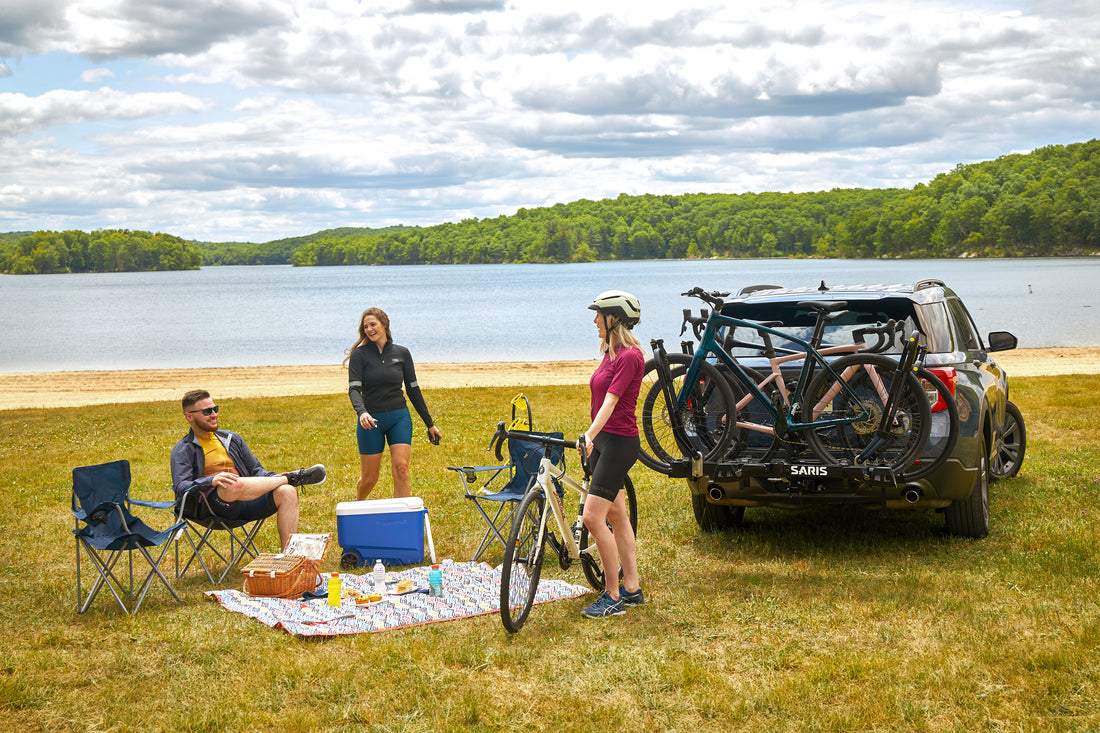You’ve got a bike and are ready to hit the road and explore – welcome to the club! You're almost done making all these big, bike-related decisions, and now it's time to find a car rack for your bike.
When it comes to transporting your bike, choosing the right bike rack can make all the difference. Two popular options are trunk and hitch bike racks. Each has its own set of advantages and considerations, making the choice dependent on your specific needs, vehicle type, budget, and biking habits.
Which Bike Rack is Best for Me?
The first question to ask yourself is: where on your car do you want to carry bikes? On the trunk or hitch of your vehicle. Here’s a closer look at the benefits of each:
Trunk Bike Racks
-
Universal Fit:
These racks are designed to fit a wide variety of vehicles, including sedans, hatchbacks, and SUVs. This flexibility makes them a versatile choice for many car owners. Some, like our Bones EX 3, even support vehicles with spoilers. -
Ease of Use:
Trunk racks are typically easy to install and remove. They attach to the back of your vehicle using straps and hooks, making setup a breeze.
-
Carries 1-3 Bikes:
Depending on the model, these racks can transport one to three bikes.
-
Portability:
Lightweight and compact, trunk racks are easy to store when not in use. They don’t take up much space, which is ideal for those with limited storage.
-
Top Tube Transportation:
Trunk racks transport bikes by their top tube, which may require additional accessories for certain bike frames. See our Bike Beam if this accessory is needed for your bicycle.
-
Affordability:
Trunk racks are generally more budget-friendly. They are a great option for cyclists looking to transport their bikes without breaking the bank.
Be sure to check our Bike Rack Fit Guide to ensure that your new bike rack will work with your vehicle.

Hitch Bike Racks
We offer two types of hitch bike racks: platform (tray-style) and hanging (mast-style). You will need a hitch receiver installed on your vehicle if it does not have one already. Hitch Receivers come in two standard sizes 1-1/4” and 2”.
Platform Hitch Racks
-
Stability:
Hitch racks offer superior stability and security for your bikes. They attach directly to the vehicle’s hitch, providing a solid and steady platform for bike transport.
-
Ease of Loading:
These racks typically sit lower to the ground, making it easier to load and unload bikes. This is especially beneficial for heavier bikes or for those who may struggle with lifting.
-
Unparalleled Compatibility and Versatility:
These racks can carry a wide range of bike styles and sizes.
-
Carries 1-4 Bikes:
Depending on the model, platform racks can transport up to four bikes.
-
Easy Hatch Access:
Most platform racks tilt away for easy access to your vehicle’s rear hatch.
-
No Frame Contact:
Platform racks hold bikes by their tires, making them ideal for carbon frames and delicate paint jobs. Never a need for a Bike Beam.

Hanging Hitch Racks
-
Lightweight and Easy to Maneuver:
These racks are lighter and more straightforward to handle.
-
Carries 2-5 Bikes:
Depending on the model, they can transport two to five bikes.
-
Protected Bike Frames:
Coated hold-downs and anti-sway features protect bike frames during transport.
-
Easy Hatch Access:
Like platform racks, most hanging racks allow easy access to your vehicle’s hatch.
-
Top Tube Transportation:
Similar to trunk racks, they transport bikes by their top tube.

Which Bike Rack is Best for My Bike?
Here are three key questions to determine the best bicycle rack for your bike:
-
Can the Rack Touch the Bike's Frame?
- If your bike has a carbon frame, opt for a platform rack to avoid frame contact. When in doubt, consult the bike’s manufacturer.
-
How Much Does Your Bike Weigh?
- Check the maximum bike weight capacity in the rack’s specifications. Saris racks are divided into two weight classes: up to 35 pounds for hanging-style racks and up to 100 pounds for platform hitch racks.
-
What Do You Want to Transport?
- Consider how many and what types of bikes you need to haul. Pay attention to factors such as wheel size, wheelbase length, and frame type. For instance, downhill mountain bikes require careful consideration of wheelbase specs, while fat bikes need trays that can hold larger tires.
What Else Should I Consider?
-
Hatch Access:
If you frequently need to access the rear of your vehicle, select a bike rack that tilts away.
-
E-Bike Compatibility:
Platform hitch racks are ideal for e-bikes due to their ability to carry heavier weights and accommodate various frame geometries. The Saris Door County and MHS Duo 2-Bike Kit are great options.
-
Lockability:
Ensure your bike and rack are secure with appropriate locking mechanisms.
-
RV Compatibility:
If you plan to use your bike rack with an RV, make sure it’s approved for such use. The Saris SuperClamp G3 HD is a great option.

Final Thoughts
Choosing between a trunk and hitch bike rack depends on your specific needs, vehicle type and budget. With the right bike rack, you can enjoy safety and convenience on every ride and hit the road with confidence. Evaluate your requirements and preferences to find the perfect Saris bike rack for your adventures.
